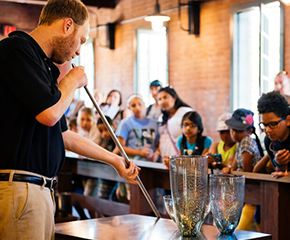
History & Timeline
When Henry Ford developed the Rouge, between 1917 and 1928, his vision was to achieve "a continuous, nonstop process from raw material to finished product, with no pause even for warehousing or storage." As history now knows, Ford succeeded on an epic scale, rolling out 4,000 vehicles a day and employing more than 100,000 at its peak.
Today, the Rouge has undergone a sweeping transformation to become a model of 21st-century sustainable design. Here’s the story behind how the automobile as we know it came of age and how Henry Ford’s pioneering industrial complex has been reborn as an international showcase for modern manufacturing and advanced, sustainable environmental design.

The History of the Ford Rouge Factory
Henry Ford wanted it all when he built the Rouge complex. Autonomy through control of every aspect of production from raw materials to finished product. What today is often called “vertical integration production.” Why depend on supplies to transform my raw materials into steel, rubber and glass, he asked, when I can do it myself? Why worry about the cost of electricity to run everything, when I can build my own power plant and generate what I need?
And he did.
Located a few miles south of Detroit at the confluence of the Rouge and Detroit Rivers, the original Rouge complex was a mile-and-a-half wide and more than a mile long. It totaled 15,767,708 square feet of floor area crisscrossed by 120 miles of conveyors. There were ore docks, steel furnaces, coke ovens, rolling mills, glass furnaces and plate-glass rollers. Buildings included a tire-making plant, stamping plant, engine casting plant, frame and assembly plant, transmission plant, radiator plant, tool and die plant, and, at one time, even a paper mill. A massive power plant produced enough electricity to light a city the size of nearby Detroit, and a soybean conversion plant turned soybeans into plastic auto parts.
The Rouge also had its own railroad with 100 miles of track and 16 locomotives. A scheduled bus network and 15 miles of paved roads kept everything and everyone on the move.
It was a city without residents. At its peak in the 1930s, more than 100,000 people worked at the Rouge. To accommodate it required a multi-station fire department, a modern police force, a fully staffed hospital and a maintenance crew 5,000 strong. One new car rolled off the line every 49 seconds. Each day, workers smelted more than 1,500 tons of iron and made 500 tons of glass, and every month 3,500 mop heads had to be replaced to keep the complex clean.
The driving vision behind the sweeping size and scale of the complex, of course, was Henry Ford and his ambition to build cars that ordinary citizens could afford and to create a way to make more of them faster than anybody else. Read on to learn more.
Learn more:


